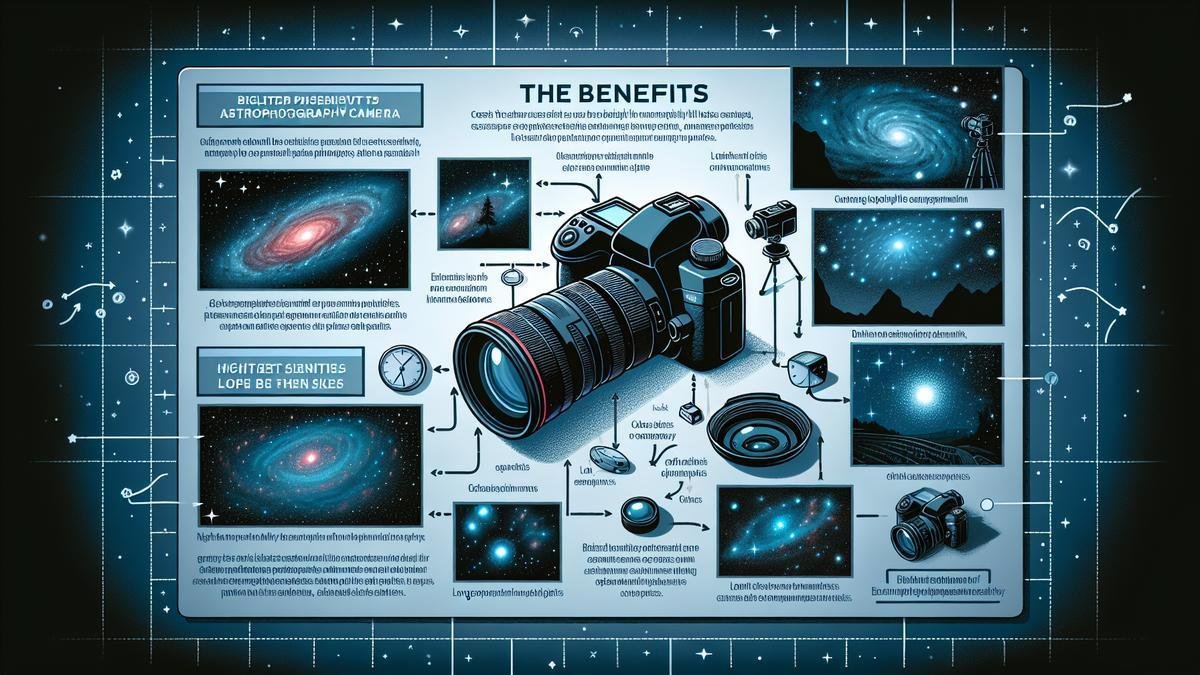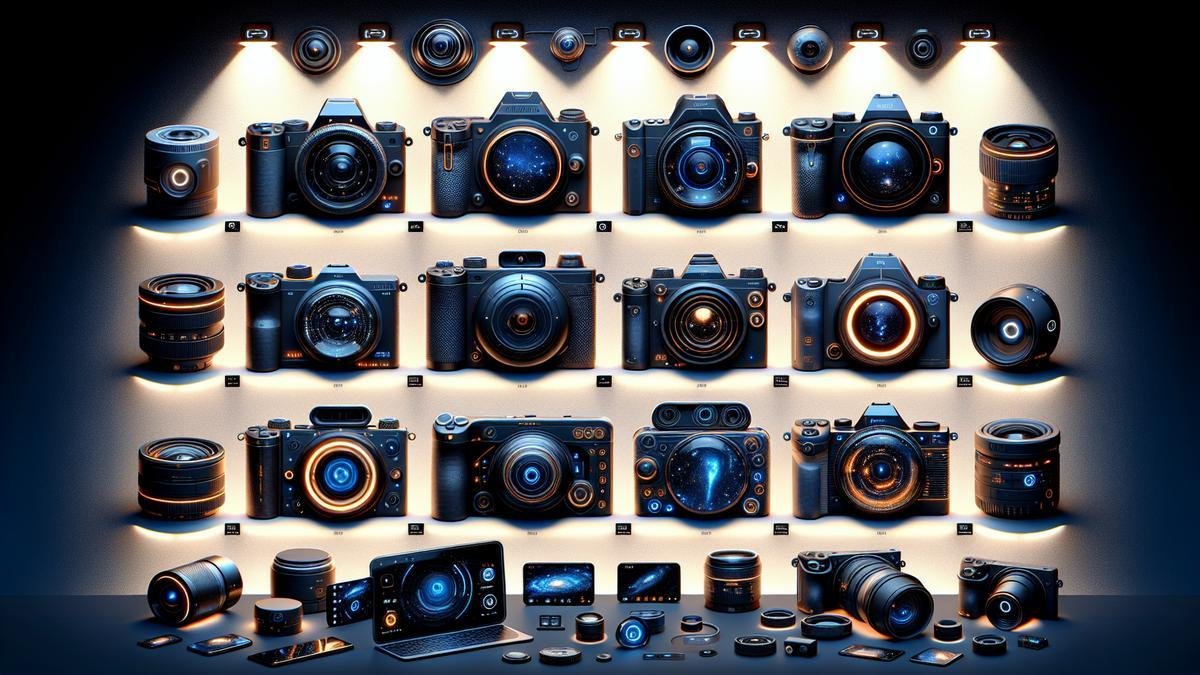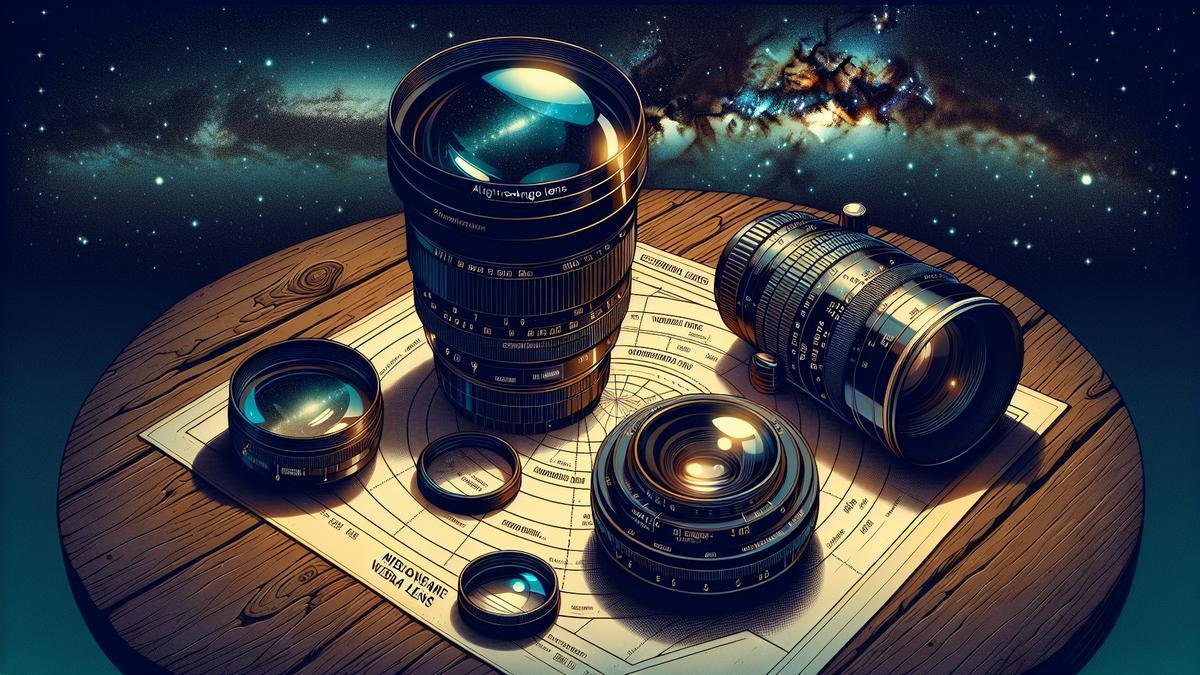The Benefits of Using a Dedicated Astrophotography Camera are vast and fascinating. Imagine capturing the night sky in stunning detail, from the milky way to distant galaxies. These specialized cameras provide enhanced image quality and superior sensor sensitivity. Youll experience clearer night sky imagery with reduced noise levels. Easy-to-use features make them perfect for beginners, while their versatility and durability offer long-term value. Join a community of astro-enthusiasts, share tips, and grow your knowledge. Ready to dive into a world of star-filled wonders? Let’s explore why these cameras are a worthy investment for anyone passionate about astrophotography.
Key Takeaways
- High-quality images of the night sky
- Better sensitivity to light
- Enhanced features for star and galaxy shots
- Reduced noise in low-light conditions
- Designed for long exposure photography
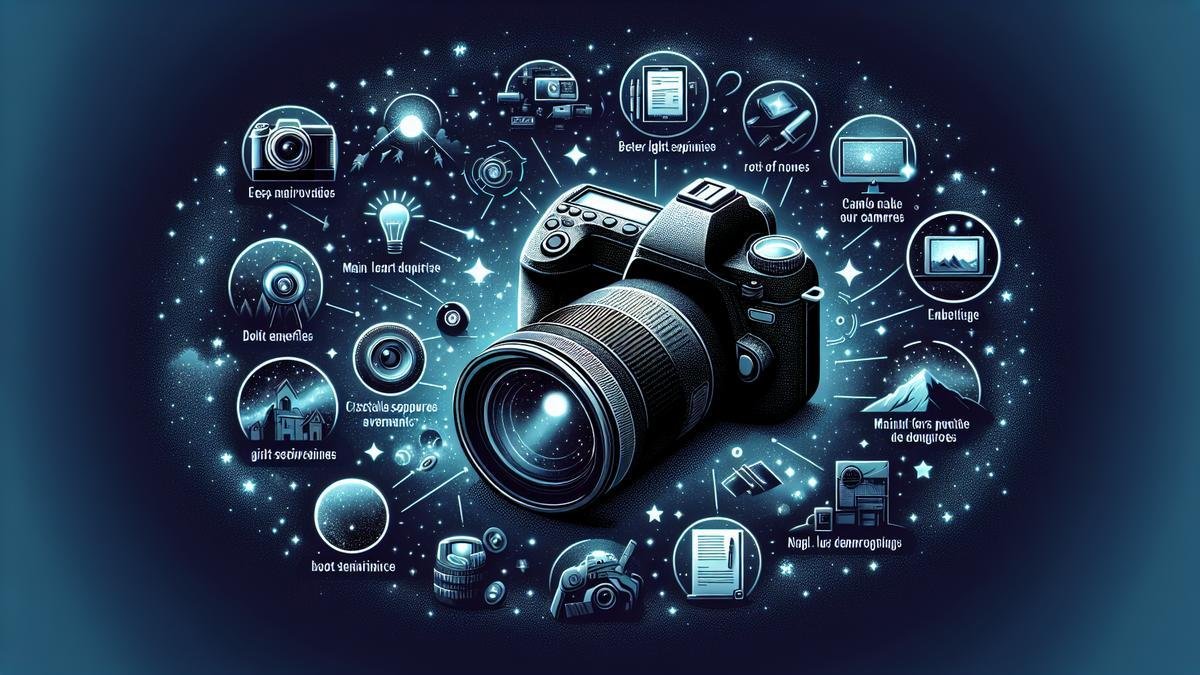
Enhanced Image Quality
Astrophotography is an art that requires precision, patience, and the right tools. Using a camera specifically designed for astrophotography can significantly enhance your image quality. Let’s dive into the key benefits.
Superior Sensor Sensitivity
When youre capturing the night sky, the sensitivity of your cameras sensor is crucial. Dedicated astrophotography cameras are equipped with sensors that are highly sensitive to light. This sensitivity allows you to capture faint celestial objects that standard cameras might miss.
Key Benefits of Superior Sensor Sensitivity:
| Feature | Benefit |
|---|---|
| High ISO Performance | Reduced noise in low-light conditions |
| Increased Light Capture | Better detail in faint objects |
| Enhanced Color Accuracy | More vivid and accurate star colors |
Imagine youre out on a clear night, aiming to capture the intricate details of a distant nebula. A camera with superior sensor sensitivity will pick up the subtle hues and fine structures, giving you a breathtaking image that standard cameras just can’t match.
Reduced Noise Levels
Noise is the bane of astrophotography. It can turn a potentially stunning image into a grainy mess. Cameras designed for astrophotography come with advanced noise reduction technologies that help keep your images clean and sharp.
Noise Reduction Techniques:
- Cooling Systems: Many astrophotography cameras have built-in cooling systems that reduce thermal noise, which is especially important during long exposures.
- Advanced Algorithms: These cameras often use sophisticated algorithms to minimize noise without sacrificing detail.
Comparison of Noise Levels:
| Camera Type | Noise Level (High ISO) |
|---|---|
| Standard DSLR | High |
| Dedicated Astrophotography Camera | Low |
When youre photographing the Milky Way, noise reduction becomes critical. The cooling systems and advanced algorithms in dedicated astrophotography cameras help you capture the galaxy in all its glory, without the distracting graininess.
Specialized Features for Night Photography
Astrophotography is a fascinating pursuit, capturing the wonders of the night sky. But to get those breathtaking shots, you need a camera specifically designed for the task. Lets dive into the specialized features that make these cameras indispensable for night photography.
Long Exposure Capabilities
One of the first things you’ll notice about dedicated astrophotography cameras is their long exposure capabilities. Regular cameras often struggle with capturing the faint light of distant stars, but these specialized devices excel at it. They allow you to keep the shutter open for extended periods, which is crucial for gathering enough light to reveal the intricate details of celestial bodies.
| Feature | Benefit |
|---|---|
| Extended Shutter Speed | Captures faint light from distant stars and galaxies. |
| Noise Reduction | Minimizes digital noise, providing clearer images. |
| High Sensitivity | Enhances the camera’s ability to detect low-light conditions effectively. |
Imagine pointing your camera at the sky and capturing the Milky Way in all its glory. With long exposure, you can do just that. The camera collects light over time, revealing details invisible to the naked eye. This feature is a game-changer for anyone passionate about night sky photography.
Advanced Cooling Systems
Another standout feature of dedicated astrophotography cameras is their advanced cooling systems. When you’re out in the field, shooting for hours on end, your camera can heat up. Heat is the enemy of clear images, causing noise and reducing the quality of your photos. That’s where these cooling systems come in.
Preventing Overheating During Long Sessions
Advanced cooling systems are designed to keep your camera at an optimal temperature, even during long sessions. This ensures that you can continue shooting without worrying about overheating. Here’s how it works:
| Cooling Method | Description |
|---|---|
| Passive Cooling | Uses heat sinks to dissipate heat naturally. |
| Active Cooling | Employs fans or Peltier coolers to actively reduce the camera’s temperature. |
Passive cooling is great for shorter sessions, as it relies on heat sinks to dissipate heat naturally. For more extended sessions, active cooling systems come into play. These use fans or Peltier coolers to actively reduce the camera’s temperature, allowing you to shoot for longer periods without compromising image quality.
Enhanced Sensor Sensitivity
Dedicated astrophotography cameras come with enhanced sensor sensitivity. Regular cameras often struggle in low-light conditions, but these specialized devices are built to thrive in them. They have sensors that are more sensitive to light, allowing you to capture stunning images even in the darkest of nights.
| Sensor Type | Benefit |
|---|---|
| CMOS | High sensitivity and low noise, ideal for astrophotography. |
| CCD | Excellent light sensitivity, though typically more expensive. |
Both CMOS and CCD sensors are excellent choices for astrophotography, each with its own set of advantages. CMOS sensors are known for their high sensitivity and low noise, making them ideal for capturing the night sky. On the other hand, CCD sensors offer even better light sensitivity, though they tend to be more expensive.
Specialized Filters
When it comes to astrophotography, specialized filters can make a world of difference. These filters help you capture specific wavelengths of light, enhancing the details of celestial objects. Whether you’re photographing nebulae, galaxies, or star clusters, the right filter can bring out the colors and details that make your images truly spectacular.
| Filter Type | Use Case |
|---|---|
| Light Pollution Filters | Reduces the impact of artificial light, ideal for urban areas. |
| Narrowband Filters | Isolates specific wavelengths, perfect for nebulae and other deep-sky objects. |
Light pollution filters are a must-have if you’re shooting in or near urban areas. They help reduce the impact of artificial light, allowing you to capture clearer images of the night sky. Narrowband filters, on the other hand, isolate specific wavelengths of light, making them perfect for capturing the intricate details of nebulae and other deep-sky objects.
Precision Mounts and Tracking Systems
To capture the night sky effectively, you need a camera that can stay perfectly still—or move with the stars. That’s where precision mounts and tracking systems come in. These systems are designed to keep your camera aligned with the stars, compensating for the Earth’s rotation.
| System Type | Benefit |
|---|---|
| Alt-Azimuth Mounts | Simple and easy to use, great for beginners. |
| Equatorial Mounts | Compensates for Earth’s rotation, ideal for long exposure shots. |
Alt-Azimuth mounts are simple and easy to use, making them great for beginners. They allow you to move the camera both horizontally and vertically. Equatorial mounts, on the other hand, are designed to compensate for the Earth’s rotation, making them ideal for long exposure shots. These mounts keep your camera aligned with the stars, ensuring that your images are sharp and clear.
High ISO Performance
Another critical feature of dedicated astrophotography cameras is their high ISO performance. ISO measures the camera’s sensitivity to light. Higher ISO settings allow you to capture more light, which is essential for night photography. However, higher ISO settings can also introduce noise. Dedicated astrophotography cameras are designed to handle high ISO settings while minimizing noise, giving you clearer, more detailed images.
| ISO Setting | Benefit |
|---|---|
| Low ISO (100-400) | Ideal for daytime photography with minimal noise. |
| Medium ISO (800-1600) | Good balance between light sensitivity and noise. |
| High ISO (3200 and above) | Excellent for low-light conditions, though may introduce some noise. |
Low ISO settings are ideal for daytime photography, offering minimal noise. Medium ISO settings provide a good balance between light sensitivity and noise, making them suitable for twilight shots. High ISO settings are excellent for low-light conditions, though they may introduce some noise. Dedicated astrophotography cameras excel at managing high ISO settings, ensuring that your night sky images are as clear and detailed as possible.
Built-in Intervalometers
A built-in intervalometer is another feature that sets dedicated astrophotography cameras apart. This handy tool allows you to set the camera to take a series of shots at specific intervals. It’s perfect for capturing time-lapse sequences of the night sky, such as the movement of stars or the progression of a meteor shower.
| Intervalometer Feature | Benefit |
|---|---|
| Time-Lapse | Captures sequences of images over time, ideal for star trails and meteor showers. |
| Remote Control | Allows you to control the camera without touching it, reducing the risk of camera shake. |
A built-in intervalometer is a game-changer for astrophotographers. It allows you to capture stunning time-lapse sequences of the night sky, showcasing the movement of stars or the progression of a meteor shower. With remote control capabilities, you can operate the camera without touching it, reducing the risk of camera shake and ensuring that your images are sharp and clear.
Customizable Settings
Dedicated astrophotography cameras often come with a range of customizable settings. These settings allow you to fine-tune the camera to suit your specific needs, giving you greater control over your shots. Whether you’re adjusting the exposure, ISO, or focus, these customizable settings ensure that you can capture the night sky in all its glory.
| Customizable Setting | Benefit |
|---|---|
| Exposure | Allows you to control the amount of light entering the camera. |
| ISO | Adjusts the camera’s sensitivity to light, essential for low-light conditions. |
| Focus | Ensures that your images are sharp and clear. |
Customizable settings are essential for astrophotography. They allow you to fine-tune the camera to suit your specific needs, ensuring that you can capture the night sky in all its glory. Whether you’re adjusting the exposure, ISO, or focus, these settings give you greater control over your shots, allowing you to capture stunning images of the night sky.
Enhanced Connectivity
Dedicated astrophotography cameras often come with enhanced connectivity options. These options allow you to connect your camera to various devices, such as smartphones, tablets, and computers. This connectivity makes it easier to control the camera remotely, transfer images, and even live-stream your astrophotography sessions.
| Connectivity Option | Benefit |
|---|---|
| Wi-Fi | Allows you to connect the camera to your smartphone or tablet. |
| Bluetooth | Enables wireless control of the camera. |
| USB | Facilitates easy transfer of images to your computer. |
Enhanced connectivity options make it easier to control your camera remotely, transfer images, and even live-stream your astrophotography sessions. Whether you’re using Wi-Fi, Bluetooth, or USB, these connectivity options ensure that you can manage your astrophotography setup with ease.
Specialized Software
Dedicated astrophotography cameras often come with specialized software designed to enhance your images. This software can help you process your photos, removing noise, enhancing details, and bringing out the colors of the night sky. Whether you’re a beginner or an experienced astrophotographer, this software can take your images to the next level.
| Software Feature | Benefit |
|---|---|
| Noise Reduction | Removes digital noise, providing clearer images. |
| Detail Enhancement | Brings out the intricate details of celestial objects. |
| Color Correction | Enhances the colors of the night sky, making your images more vibrant. |
Specialized software is a valuable tool for astrophotographers. It can help you process your photos, removing noise, enhancing details, and bringing out the colors of the night sky. Whether you’re a beginner or an experienced astrophotographer, this software can take your images to the next level.
Durability and Build Quality
When you’re out in the field, you need a camera that can withstand the elements. That’s why dedicated astrophotography cameras are built to be durable and high-quality. These cameras are designed to withstand extreme temperatures, moisture, and dust, ensuring that they can perform in a variety of conditions.
| Build Quality Feature | Benefit |
|---|---|
| Weather-Sealed | Protects the camera from moisture and dust. |
| Robust Construction | Ensures the camera can withstand extreme temperatures and rough handling. |
Durability and build quality are essential for astrophotography. These cameras are designed to withstand extreme temperatures, moisture, and dust, ensuring that they can perform in a variety of conditions. Whether you’re shooting in the freezing cold or the sweltering heat, you can rely on your dedicated astrophotography camera to deliver stunning images.
Versatility with Accessories
Dedicated astrophotography cameras are also designed to be versatile with a range of accessories. From specialized lenses to tripods and filters, these cameras can be customized to suit your specific needs. This versatility ensures that you can capture the night sky in all its glory, regardless of your location or the conditions.
| Accessory | Benefit |
|---|---|
| Specialized Lenses | Enhance the camera’s ability to capture detailed images of celestial objects. |
| Tripods | Provide stability and precision, essential for long exposure shots. |
| Filters | Enhance the details of celestial objects, bringing out the colors and contrasts. |
Versatility with accessories is a key feature of dedicated astrophotography cameras. From specialized lenses to tripods and filters, these cameras can be customized to suit your specific needs. This versatility ensures that you can capture the night sky in all its glory, regardless of your location or the conditions.
User-Friendly Interface
Finally, dedicated astrophotography cameras often come with a user-friendly interface. This interface makes it easier to navigate the camera’s settings and features, ensuring that you can focus on capturing stunning images rather than fiddling with complicated controls.
| Interface Feature | Benefit |
|---|---|
| Intuitive Controls | Makes it easy to navigate the camera’s settings and features. |
| Clear Display | Provides a clear view of your images and settings, even in low light. |
A user-friendly interface is essential for astrophotography. It makes it easier to navigate the camera’s settings and features, ensuring that you can focus on capturing stunning images rather than fiddling with complicated controls. Whether you’re a beginner or an experienced astrophotographer, a user-friendly interface can make your astrophotography experience more enjoyable and productive.
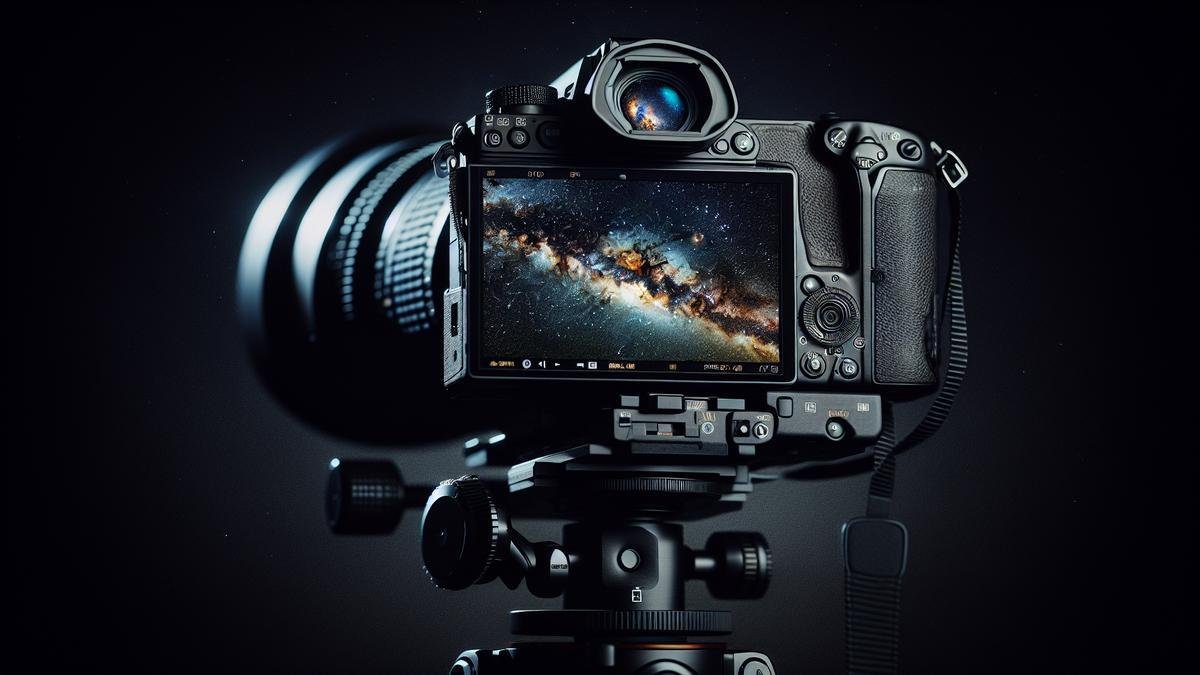
Ease of Use for Beginners
User-Friendly Interface
Embarking on your journey into astrophotography can feel like stepping into a vast, starry expanse. But don’t worry, dedicated astrophotography cameras are here to guide you through the cosmos. These cameras come equipped with user-friendly interfaces designed to make your stargazing adventures as smooth as gliding through space.
Imagine you’re holding a camera that feels like it was custom-built for you. The buttons are where you intuitively reach for them, and the menu layout makes sense without needing a degree in rocket science. This user-centric design helps you focus on capturing the night sky rather than fiddling with complex settings.
A well-designed interface can make all the difference. Its like having a trusty co-pilot in your hands, guiding you through the darkness and helping you capture those elusive celestial wonders. The simplicity of these interfaces means you spend less time learning and more time shooting.
Pre-Set Astrophotography Modes
Now, let’s talk about the magic of pre-set astrophotography modes. These are like having a cheat sheet for the cosmos. You dont have to worry about adjusting every little setting; the camera does the heavy lifting for you.
For instance, when you’re aiming to capture the Milky Way, you can select a mode specifically designed for this purpose. The camera will automatically adjust the exposure, ISO, and aperture to optimal settings. It’s like having a seasoned astrophotographer whispering in your ear, “I’ve got this.”
These pre-set modes are incredibly helpful, especially for beginners. They take the guesswork out of the equation and allow you to focus on framing your shot. Whether you’re capturing a meteor shower or a distant galaxy, these modes ensure you get the best possible results with minimal effort.
Simplifying the Learning Curve
Navigating the complexities of astrophotography can be daunting, but dedicated cameras simplify the learning curve. Think of it as having a mentor whos always there to guide you.
One of the most significant benefits of these cameras is their ability to make complex processes more straightforward. For example, many cameras offer built-in tutorials that walk you through various settings and techniques. It’s like having a personal tutor available 24/7.
Additionally, these cameras often come with robust support communities. You can easily find forums, online tutorials, and even local groups dedicated to helping you improve your skills. This support network is invaluable as you navigate the night sky.
Benefits of Dedicated Astrophotography Cameras
Dedicated astrophotography cameras are specifically engineered to capture the night sky in all its glory. They offer features that standard cameras simply cant match. Below is a table highlighting some of these features and their benefits:
| Feature | Benefit |
|---|---|
| High ISO Capabilities | Capture stunning images in low light without excessive noise. |
| Long Exposure Options | Perfect for capturing detailed images of stars, galaxies, and nebulae. |
| Advanced Tracking Systems | Ensures sharp images by compensating for the Earth’s rotation. |
| Specialized Sensors | Enhanced sensitivity to light, capturing more detail in the night sky. |
| Cooling Systems | Reduces noise in long exposures, resulting in cleaner images. |
These features are tailored to meet the unique challenges of astrophotography, making it easier for you to capture breathtaking images of the night sky.
High ISO Capabilities
One of the standout features of dedicated astrophotography cameras is their high ISO capabilities. High ISO settings allow you to capture images in low light conditions without introducing excessive noise. This is crucial when photographing the night sky, where light is scarce.
Imagine you’re out in the middle of nowhere, far from city lights, and you want to capture the Milky Way. With a high ISO setting, you can capture the faint light from the stars without worrying about noise ruining your shot. It’s like turning up the volume on a whisper without adding static.
Long Exposure Options
Long exposure is a cornerstone of astrophotography. It allows you to capture the movement of stars, creating stunning images that showcase the beauty of the night sky. Dedicated astrophotography cameras offer advanced long exposure options, making it easier for you to capture these mesmerizing shots.
These cameras often come with features like bulb mode and intervalometers, allowing you to take long exposures without holding down the shutter button. This is particularly useful for capturing star trails or the movement of celestial objects.
Advanced Tracking Systems
One of the challenges of astrophotography is compensating for the Earth’s rotation. As the Earth rotates, stars appear to move across the sky. This can result in blurry images if you’re not using a tracking system.
Dedicated astrophotography cameras often come with advanced tracking systems that automatically adjust for the Earth’s rotation. This ensures that your images are sharp and clear, even during long exposures. It’s like having a built-in guide that keeps your camera steady as the stars move across the sky.
Specialized Sensors
The sensors in dedicated astrophotography cameras are designed to capture more light, resulting in more detailed images. These sensors are often larger and more sensitive than those found in standard cameras, allowing you to capture faint celestial objects with ease.
Imagine you’re trying to capture a distant galaxy. With a specialized sensor, your camera can pick up the faint light from the galaxy, revealing details that would be impossible to capture with a standard camera. It’s like having a telescope built into your camera, allowing you to see further into the cosmos.
Cooling Systems
Long exposures can generate a lot of heat, which can introduce noise into your images. Dedicated astrophotography cameras often come with cooling systems that help dissipate this heat, resulting in cleaner images.
These cooling systems are like having an air conditioner for your camera, keeping it cool and reducing noise during long exposures. This is particularly useful when capturing detailed images of stars, galaxies, and nebulae.
Additional Benefits of Dedicated Astrophotography Cameras
Dedicated astrophotography cameras offer a host of other benefits that make them ideal for capturing the night sky. Below is a table highlighting some of these additional benefits:
| Benefit | Description |
|---|---|
| Enhanced Dynamic Range | Captures a wider range of light and dark, revealing more detail in your images. |
| Customizable Settings | Allows you to fine-tune your camera settings for optimal results. |
| Robust Build Quality | Designed to withstand harsh conditions, ensuring durability. |
| Advanced Software Integration | Seamlessly integrates with software for post-processing and image stacking. |
| Versatile Mounting Options | Compatible with a wide range of mounts and tripods for stability. |
These benefits make dedicated astrophotography cameras a valuable tool for anyone looking to capture the beauty of the night sky.
Enhanced Dynamic Range
Dynamic range refers to the range of light and dark that a camera can capture. Dedicated astrophotography cameras often have enhanced dynamic range, allowing you to capture more detail in your images.
Imagine you’re photographing a landscape with a bright moon and dark shadows. With enhanced dynamic range, your camera can capture both the bright moon and the dark shadows without losing detail. This results in more vibrant and detailed images.
Customizable Settings
Dedicated astrophotography cameras offer a high degree of customization, allowing you to fine-tune your settings for optimal results. This is particularly useful when you’re trying to capture specific celestial objects or phenomena.
For example, if you’re photographing a meteor shower, you can customize your settings to capture the fast-moving meteors without introducing noise. This level of customization ensures that you get the best possible results, no matter what you’re photographing.
Robust Build Quality
Astrophotography often involves shooting in harsh conditions, such as cold nights or windy environments. Dedicated astrophotography cameras are built to withstand these conditions, ensuring durability and reliability.
These cameras are like rugged explorers, ready to brave the elements to capture stunning images of the night sky. Their robust build quality means you can rely on them to perform, no matter what conditions you’re shooting in.
Advanced Software Integration
Post-processing is an essential part of astrophotography, and dedicated cameras often come with advanced software integration to make this process easier. This includes features like image stacking and noise reduction, which help you create stunning final images.
Imagine you’ve captured a series of images of a nebula. With advanced software integration, you can easily stack these images to create a single, detailed image. This process is like assembling a puzzle, where each piece adds to the overall picture.
Versatile Mounting Options
Stability is crucial in astrophotography, and dedicated cameras often come with versatile mounting options to ensure your camera stays steady during long exposures. This includes compatibility with a wide range of mounts and tripods.
These mounting options are like the foundation of a skyscraper, providing the stability you need to capture sharp, detailed images. Whether you’re using a simple tripod or an advanced tracking mount, these cameras ensure your setup is rock-solid.
Versatility in Various Conditions
Adaptability to Different Light Conditions
Astrophotography cameras are like the Swiss Army knives of the night sky. Theyre built to handle a wide range of light conditions, making them indispensable for capturing the cosmos. Whether youre shooting under the bright glow of a full moon or the pitch-black canvas of a new moon, these cameras have the tools you need.
Low-Light Performance
One of the standout features of dedicated astrophotography cameras is their low-light performance. These cameras often come equipped with larger sensors and higher ISO capabilities, allowing them to capture faint stars and distant galaxies with remarkable clarity. You wont have to worry about noise ruining your shots, even when you push the ISO to its limits.
| Feature | Benefit |
|---|---|
| Large Sensors | Capture more light, better image quality |
| High ISO | Reduce noise, capture faint objects |
| Noise Reduction | Cleaner images in low-light conditions |
High Dynamic Range
Another key aspect is the high dynamic range (HDR). This allows the camera to capture a broader spectrum of light, from the darkest shadows to the brightest highlights. This is particularly useful when shooting celestial events like lunar eclipses or the Milky Way, where light conditions can vary dramatically within a single frame.
Compatibility with Various Lenses
When it comes to lenses, versatility is the name of the game. Astrophotography cameras are designed to work seamlessly with a variety of lenses, giving you the flexibility to shoot different types of astronomical objects.
Wide-Angle Lenses
Wide-angle lenses are perfect for capturing expansive views of the night sky. They allow you to include more of the celestial landscape in your frame, making them ideal for photographing the Milky Way or meteor showers. Check out this guide on essential lenses for capturing the night sky to find the best options.
| Lens Type | Ideal For |
|---|---|
| Wide-Angle | Milky Way, meteor showers |
| Telephoto | Planets, moon, distant galaxies |
| Macro | Close-up shots of lunar craters, star clusters |
Telephoto Lenses
For those who want to zoom in on specific celestial objects like planets or the moon, telephoto lenses are your best bet. These lenses allow you to get up close and personal with your subjects, capturing intricate details that are often missed with standard lenses.
Macro Lenses
Macro lenses may not be the first thing that comes to mind for astrophotography, but they can be incredibly useful for capturing close-up shots of lunar craters or star clusters. They offer a unique perspective that adds variety to your portfolio.
Maximizing Your Shooting Options
Having a camera that can adapt to various conditions and work with different lenses maximizes your shooting options. This flexibility is crucial for any astrophotographer looking to capture the night sky in all its glory.
Using Filters
Filters can dramatically enhance your astrophotography. Whether youre trying to reduce light pollution or bring out the colors in a nebula, using the right filter can make a world of difference. For more information on the best filters to use, visit this comprehensive guide.
| Filter Type | Benefit |
|---|---|
| Light Pollution | Reduces city lights, clearer sky |
| Narrowband | Enhances specific wavelengths, vivid colors |
| UV/IR Cut | Reduces unwanted light, sharper images |
Star Trackers
Star trackers are another essential tool for maximizing your shooting options. They allow your camera to follow the movement of the stars, enabling longer exposures without star trails. This is especially useful for capturing detailed images of deep-sky objects. Learn more about using star trackers here.
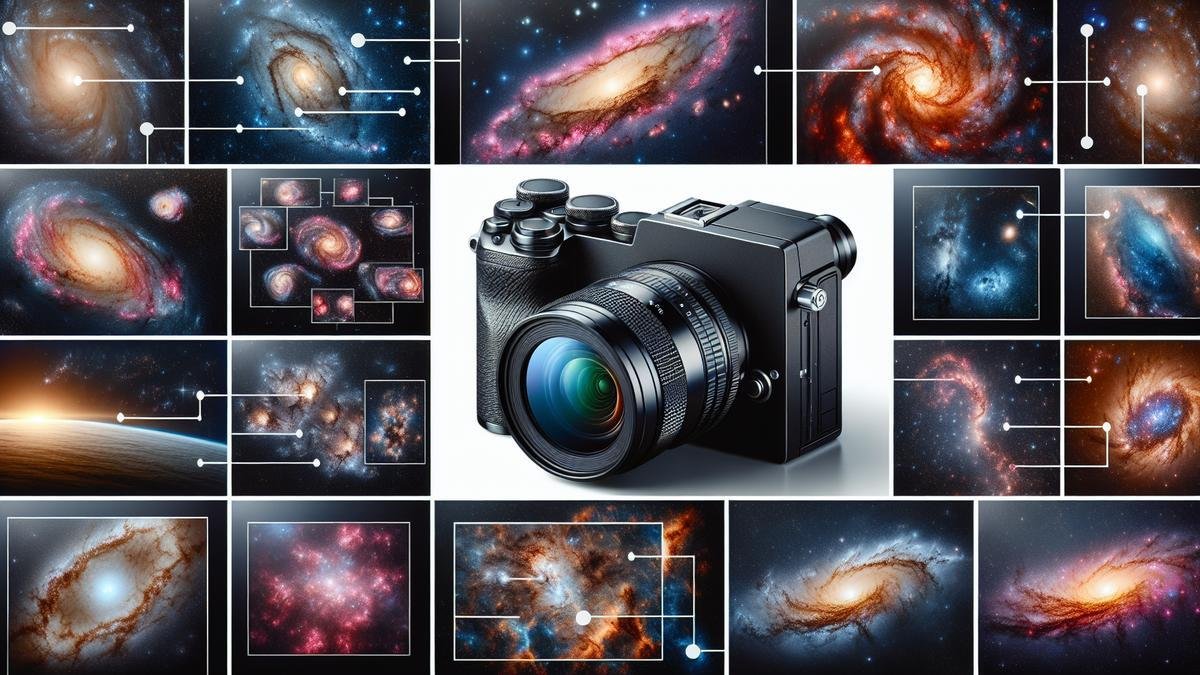
Cost-Effectiveness in the Long Run
When diving into the captivating world of astrophotography, you might wonder about the financial implications of investing in dedicated equipment. While the initial cost may seem steep, the long-term benefits are substantial. Let’s explore how a camera specifically designed for capturing the night sky can be a cost-effective choice.
Reducing the Need for Additional Equipment
Dedicated astrophotography cameras often come equipped with features that eliminate the need for extra gear. These cameras are designed to excel in low-light conditions, reducing the necessity for high-end lenses, filters, and other accessories.
| Feature | Benefit | Cost Savings |
|---|---|---|
| Built-in Cooling Systems | Reduces noise in long exposures | Saves on external cooling devices |
| High Sensitivity Sensors | Captures more detail in low light | Eliminates the need for multiple high-ISO lenses |
| Advanced Tracking Capabilities | Keeps stars sharp during long exposures | Reduces the need for expensive tracking mounts |
By investing in a camera that already includes these features, you can save a significant amount on additional equipment. This makes the initial investment more economical in the long run.
Longevity and Durability
Another advantage of dedicated astrophotography cameras is their durability. These cameras are built to withstand the rigors of outdoor night photography, including extreme temperatures and humidity. This longevity ensures that your investment will last for years, providing you with countless opportunities to capture the beauty of the night sky.
Community and Support
Access to Expert Advice
Navigating the complexities of astrophotography can be daunting. But access to expert advice can make a world of difference. When you use a camera specifically designed for astrophotography, you’re not just buying a piece of equipment. You’re entering a community of enthusiasts and professionals who share your passion. This network is a goldmine of knowledge and experience.
Imagine you’re struggling with capturing the fine details of a distant nebula. You can easily reach out to experts who can guide you through the nuances of your camera settings. They can help you tweak your exposure times, ISO levels, and even suggest the best filters for enhancing your shots. The advice you receive is often tailored to the specific capabilities of your camera, making it incredibly valuable.
Here are some common issues and the expert advice you might receive:
| Issue | Expert Advice |
|---|---|
| Blurry Images | Use a sturdy tripod and a remote shutter release to avoid camera shake. For more information on stability, check out tripods for astrophotography. |
| Poor Star Colors | Adjust your white balance and consider using a light pollution filter. Learn more about enhancing star colors here. |
| Noise in Images | Use a lower ISO and longer exposure times. For tips on high ISO settings, visit high ISO tips and tricks. |
Joining Astrophotography Groups
Joining astrophotography groups can be a game-changer. These groups often include forums, social media pages, and local meetups where you can share your experiences and get feedback on your work. The camaraderie and support you find in these groups can be incredibly motivating.
For instance, you might join a local astrophotography club that organizes monthly stargazing events. Here, you can test your camera’s capabilities in different settings and conditions. You can also participate in group projects, like photographing a meteor shower or capturing the Milky Way. The collective knowledge and experience of the group can help you improve your skills rapidly.
Here are some benefits of joining astrophotography groups:
| Benefit | Description |
|---|---|
| Shared Knowledge | Learn from the experiences of others and avoid common pitfalls. |
| Group Projects | Work on collaborative projects that push your skills to the next level. |
| Equipment Sharing | Get hands-on experience with different types of equipment. For more on choosing the best telescope, visit this guide. |
Frequently Asked Questions
What are the main advantages of an astrophotography camera?
Astrophotography cameras give you clear, detailed night sky pictures. Their sensors are specifically built to capture faint starlight with low noise.
How does an astrophotography camera differ from a regular camera?
These cameras have higher sensitivity to light, longer exposure settings, and better cooling systems to reduce noise.
Do I need special software with an astrophotography camera?
Yes! Specialized software helps you process and stack your images, bringing out details in those dark skies.
Can beginners use astrophotography cameras successfully?
Absolutely. Many models are user-friendly and come with guides to help you get started.
What’s the cost of using an astrophotography camera?
While they can be pricier than regular cameras, The Benefits of Using a Dedicated Astrophotography Camera are worth the investment if you’re serious about capturing the cosmos.

